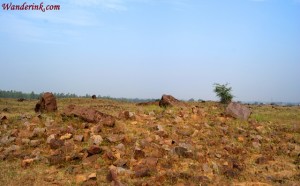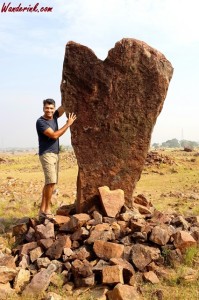“Do I want to see what?” I asked Soumik Dey of Chhattisgarh Tourism Board when we were charting my itinerary into the south of Chhattisgarh.
It was not that I didn’t hear him say the ‘Stonehenge of India’ but never one for epithets – after all, piggybacking can take you only so far – the question was reflex and rhetoric in equal part. I told him that I’d rather spend more time gazing at the Tandula Canal from the colonial era guesthouse by its banks at Balod where I would be staying. A month ago Soumik had put together my road trip into the north so I believed him when he said later “Do it, you will like it.” In fact, my interest was already piqued when somebody had earlier dismissed it as a ‘bunch of stones’ and ‘advised’ me not to waste my time visiting a place where no tourist went. Later, its near-obscurity intrigued me. I knew I had to be there.
None of the locals I spoke to at Balod had heard about the prehistoric burial site at Karkabhat, 12 km along the Dhamtari road. Those who had heard of it hadn’t seen it. ‘Or surely passed by then who’d take note of a ‘bunch of stones?’ One guy took me to the sugar factory in Karkabhat; in exasperation I had asked him to take me to all the attractions there. We asked around some more, passed by the ubiquitous pond and adobe walls announcing spoken English courses in Hindi, bullock carts slumbering along in an era of its own, drove over bridges crossing scenic rivulets. Finally a primary school teacher took a break from her class and pointed us the right way. We reached a vast open ground which from a distance actually looked like a bunch of stones stacked haphazardly for loading into trucks. But peer closer and a design reveals.
Spread across five square kilometres were menhirs marking megalithic burial sites, a little removed from the main road. You can reach them only by foot as it is schist-strewn territory. The layers of boulders around the towering menhirs were found to be arranged in a pyramidal design gradually peaking towards the top. Studies conducted in the area have identified three types of menhirs: conical, pointed obliquely and bifurcated like a fishtail. While the finished surface of each menhir faced north, the unfinished, corrugated surface faced south. These menhirs were further placed inclining towards the east or the west and their placements and positioning denoted the solar positions at the time of their erection. These menhirs were thus used to indicate the exact period and time of the year when the person died. Karkabhat was one of the rarest discoveries of menhirs anywhere in the country.
Excavations carried out in 1990 showed that the megalithic people were well-versed in sepulchral architecture which involved transporting and erecting the huge menhirs – obviously a superhuman feat. In some cases huge boulders were also transported and placed around the menhirs. There are also multiple burial sites which meant more than one menhir placed equidistant from each other and facing the right direction. Excavations have also unearthed daggers and spearheads, arrowheads and other instruments of attack and defence. This showed the people of the megalithic age were pastoral in nature. Surely not much time they would have invested in setting them up which made it all the more appalling.
Despite these discoveries which point to the astounding scientific accomplishments of a prehistoric society, little effort has gone into its conservation. Both the archaeological and tourism departments seem to have consigned Karkabhat to a whirlpool of lethe; unless rescued now it’s going to be too late. It may not be religiously significant like the other more celebrated, venerated excavations in Chhattisgarh but it surely makes a better case than Vedic airplanes at Science Congresses. I tried to explain to my friend and local guide some of these and he seemed to be genuinely amazed at what he heard. He spoke to some people who had gathered around us now and turned to me. People carted away cairns from the site with no compunction for their construction needs, he informed me.
“It could be because they don’t know its significance.” He added not very convinced himself.
How to reach: Raipur to Dhamtari is 82 km along the Jagdalpur highway. From Dhamtari head 10 km straight along the highway towards Kanker and you will reach Kurur junction. Take right from here towards Balod (45 km); Karkabhat is 13 km before Balod.















Wow! And no one’s heard of all this! Were these tomb stones?
Tombstones, in a way. But no inscription, just the placement which apparently says a lot. Right, truly amazing!
I’m curious as to why some digs have received unmerited attention while this corner of Incredible India lies ignored. Despite the same archaeologist/expert helming excavations.
Beats me… must be the lack of glory/rewards associated with a non-religious excavation?
wow!!! lucky you, getting to see this! makes me want to go again, just to explore unknown sites like this!
You should. You should. There is more! 🙂